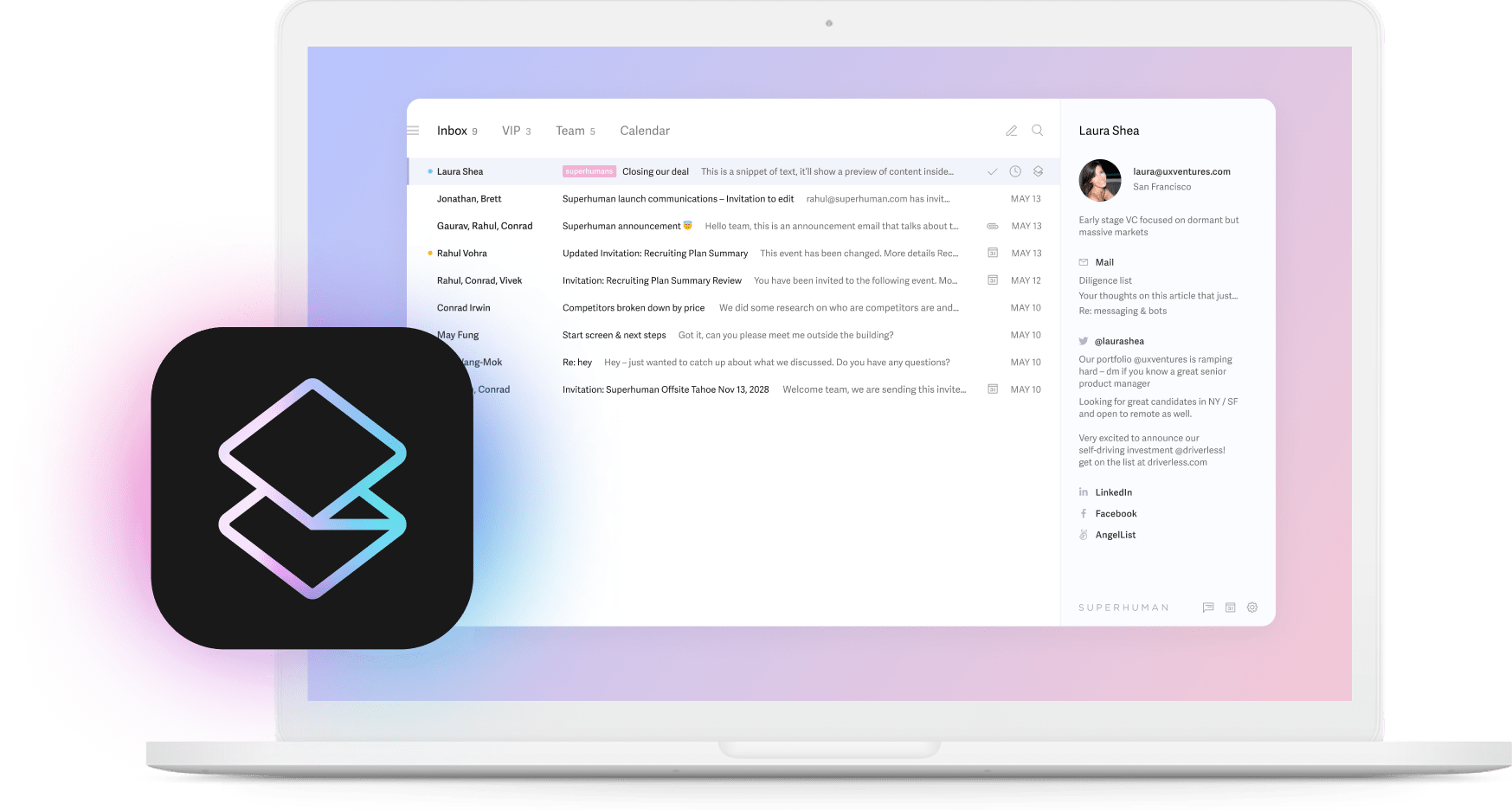
Email automation software can help you reclaim time lost to the daily deluge of messages hitting your inbox. With professionals receiving about 120 emails daily, manual handling consumes nearly 30% of your workday.
The problem extends beyond wasted time. When important messages get buried under promotional fluff, or responses take days instead of hours, real problems emerge: missed opportunities, confused team members, and bottlenecks that ripple through your entire organization.
Email remains the backbone of business communication, but without smart automation, it quickly becomes your biggest productivity vampire. As message volumes keep climbing, finding better ways to manage this flood is essential for anyone who wants to stay effective.
Why email automation software is a strategic necessity
Most B2B professionals now save at least one full workday every week with AI and automation tools. That's 50+ reclaimed workdays annually that you can redirect toward work that actually moves the needle.
When implemented thoughtfully, these tools help your team respond faster, maintain consistent follow-up, and deliver exceptional service that scales. Superhuman customers respond to emails twice as fast and one full day sooner than others — a genuine advantage when quick responses directly impact deals and relationships.
Then there's the visibility factor. Email automation software shows you exactly how communication flows through your team, preventing important messages from vanishing into the void. You can spot bottlenecks, balance workloads, and ensure customer inquiries get prompt attention.
Top performers see the biggest gains. High performers using AI are 14% more productive per week than their peers. They're also 2.5 times more likely to use AI features regularly, suggesting that consistent automation creates a compound effect on productivity.
Looking ahead, 66% of professionals expect AI to triple productivity within five years. Executives are even more optimistic, being twice as likely to predict 10x gains. This explains why email automation software has become essential infrastructure for teams who want to stay ahead.
What to look for in email automation software
When shopping for email automation software, focus on features that save you time while boosting engagement and conversions. The best email marketing software turns your approach from reactive firefighting to strategic communication.
Smart automation triggers
Look for tools with triggers that respond to how people interact with your emails:
- Open tracking that shows exactly when someone reads your message
- Reply detection that prevents unnecessary follow-ups
- Time-based triggers for sending emails when they're most likely to be read
- Action-based sequences that automatically follow up when needed
These triggers eliminate the mental burden of remembering to check in, freeing up mental space and actual hours each week.
Personalization and segmentation
Good email automation software lets you group your audience by:
- Past behavior and engagement
- Customer lifecycle stage
- Demographic information
- Purchase patterns
The best platforms include dynamic content that personalizes messages automatically. This makes recipients feel seen and understood, dramatically improving open and conversion rates.
Workflow and team collaboration features
For teams, look for:
- Shared templates and sequences that keep messaging consistent
- Collaborative drafting and approval workflows, like Team Comments for email collaboration
- Tag-based organization for easy sorting
- Permission controls for feature access
These features ensure smooth handoffs between team members with no awkward communication gaps or dropped balls.
Analytics and deliverability insights
Real-time performance tracking helps you constantly improve. Choose tools with:
- Open, click, and response rate tracking
- A/B testing to refine your approach
- Deliverability monitoring to ensure inbox placement
- Industry performance benchmarks
These insights help you continuously improve based on what actually works, not what you think might work.
Integration capabilities
Your email automation software should play nicely with your other tools. Industry leaders are 38% more likely to use specialized email tools often because they integrate better. Look for connections with:
- CRM systems for accurate contact data
- Calendar tools for scheduling
- Project management platforms for coordination
- Content management systems for resource sharing
These integrations ensure your email system works with your productivity ecosystem rather than becoming an isolated silo. When your email and CRM communicate, you get better data accuracy, genuine personalization, and workflows that don't require constant task-switching.
1. Superhuman — best for high-performance email workflows
Superhuman delivers the premium experience that busy professionals secretly crave, enhancing the email experience for Gmail users. For more insights, check out their Gmail client guide.
Built for speed and responsiveness, Superhuman helps you handle email volumes that would break conventional clients. By leveraging AI to enhance speed and accuracy in email management, Superhuman customers send and respond to 72% more emails per hour than non-users.
Superhuman's AI-powered email client delivers tangible business impact through key features:
- Superhuman AI: Writes full emails from short phrases while maintaining your personal tone by learning from your writing history
- Split Inbox: Automatically categorizes emails to spotlight high-priority messages from colleagues, executives, and important tools
- Instant Reply & Auto-Summarize: Suggests smart reply drafts and summarizes long email threads to accelerate understanding and action
- Send Later & Reminders: Schedules emails for optimal delivery times and sets automated follow-ups without added mental overhead
- Snippets: Enables quick insertion of prewritten templates and facilitates sharing effective replies across teams
- Shared Conversations & Team Comments: Promotes alignment and rapid internal decision-making directly within email
- Real-Time Read Statuses: Shows exactly when and on what device an email was read for more accurate follow-up
- Social Insights: Surfaces social media details about contacts to personalize outreach and deepen relationships
These features help customers save 4 hours every week, respond 12 hours faster, and handle twice as many emails in the same amount of time. With various Superhuman pricing options, it's accessible to professionals seeking a real edge in email management.
This impact hits hardest for executives, founders, sales teams, and operations professionals who practically live in their inbox. As Akash Bhatia, Managing Director & Senior Partner at BCG puts it: "I can't imagine email without Superhuman. It would be like going back to the stone age."
Try Superhuman2. HubSpot — best for marketing and sales automation
HubSpot brings together CRM, email marketing, and automation into one cohesive platform. Its superpower? Bridging the gap between marketing and sales teams.
The all-in-one approach means you're not juggling separate tools and databases. You get one comprehensive platform handling everything from lead generation to customer relationship management. This creates a single source of truth, with customer data flowing smoothly between departments.
HubSpot's personalization capabilities shine brightly. Create campaigns that feel tailor-made using advanced segmentation based on behavior, demographics, and engagement history. This means sending the right message to the right person at the perfect moment, significantly boosting conversion rates.
The analytics dashboard tells you exactly what's working. HubSpot provides detailed, real-time campaign performance tracking, giving you actionable insights to refine your strategies. Companies using HubSpot's integrated marketing automation have seen a 451% increase in qualified leads.
For sales teams, automatic lead scoring and nurturing qualifies prospects based on their interactions with your content. This focuses your sales team on the most promising opportunities while marketing continues nurturing leads that aren't ready to buy yet.
HubSpot works best for marketing teams running complex campaigns, companies with sophisticated sales cycles, and businesses wanting unified marketing and sales data. Its automated workflows simplify lead nurturing and segmentation, making it valuable for teams scaling their outreach efforts.
3. Mailchimp — best for small businesses and e-commerce
Mailchimp feels like it was built specifically for small businesses and e-commerce shops looking to grow without hiring a tech team. It blends an easy-to-use interface with powerful automation features that actually deliver results.
Small operations love Mailchimp because it doesn't require a degree in computer science to use. Creating professional campaigns is straightforward using their template library, yet you still get access to automation tools handling everything from welcome sequences to abandoned cart reminders.
E-commerce businesses particularly benefit from Mailchimp's seamless integration with platforms like Shopify, making it easy to sync product catalogs and customer data. This enables targeted campaigns based on purchase history and browsing behavior — the kind of personalization that used to require enterprise-level budgets.
The tiered pricing structure means startups can begin with basic newsletter functionality and gradually add more advanced automations as they grow, without breaking the bank.
If you're new to email marketing or scaling an e-commerce operation without a dedicated email specialist, Mailchimp offers the perfect balance of powerful features without overwhelming complexity.
4. ActiveCampaign — best for behavioral email automation
Want emails that adapt to how people actually behave? ActiveCampaign stands out by combining sophisticated email marketing with a built-in CRM system that tracks every customer interaction.
ActiveCampaign excels at building advanced sequences triggered by specific customer behaviors. Instead of sending identical messages to everyone, you create workflows responding to how customers interact with your business — whether they've viewed certain products, clicked specific links, or reached important milestones in their journey.
The customer journey mapping tools let you visualize and optimize the entire lifecycle marketing process. This makes ActiveCampaign particularly valuable for businesses with complex purchase journeys requiring multiple touchpoint nurturing.
ActiveCampaign's advanced segmentation options deliver measurable results. Many SaaS companies have seen measurable gains by combining email campaigns with CRM data to create personalized, behavior-driven messaging that boosts engagement and retention.
If you want emails that feel personally crafted for each recipient and automatically adapt based on their actions, ActiveCampaign provides the robust framework needed to build these sophisticated, responsive marketing systems.
5. Customer.io — best for product and app-based companies
Running a SaaS business or product-focused company? Customer.io was built specifically for you. What makes it stand out is how it responds to specific customer actions within your product.
Unlike platforms focused on time-based campaigns, Customer.io's event-based triggers significantly improve engagement by reaching customers precisely when their interest peaks. This makes it perfect for product-led growth strategies where customer behavior drives marketing efforts.
The platform shines with flexible automation logic for complex, multi-step workflows. Build sophisticated journeys based on custom events and customer data, creating experiences that respond exactly to how people use your product.
Developers particularly appreciate Customer.io's API access and deep customization options. This makes integration with your existing tech stack smoother and allows tailored communications matching your specific requirements.
Another major advantage is Customer.io's unified approach for both transactional and marketing emails in one platform. This eliminates separate systems for different communication types, streamlining your workflow and ensuring consistent messaging across all customer touchpoints.
6. Outreach — best for sales engagement automation
Outreach solves a specific problem: keeping your sales pipeline moving when you're juggling hundreds of prospects at different stages. When your sales process demands methodical follow-up and relationship nurturing, this platform delivers the automation tools you need.
Outreach proves most valuable for B2B sales teams where consistent follow-up determines closed deals versus missed opportunities. It works best for companies with longer sales cycles needing to nurture relationships over time and organizations seeking measurable results in outbound prospecting. For teams evaluating cold email software platforms, Outreach offers robust features tailored to sales engagement automation.
7. Front — best for shared inbox collaboration
Front turns email from a solo activity into a team sport. It's built for customer-facing teams who need to collaborate on external communications without stepping on each other's toes.
With Front, your team gets a shared inbox experience creating a central hub for all customer interactions. This suits support, success, and account management teams needing visibility into customer communications across the organization.
Front's key capabilities include:
- Shared inbox functionality allowing multiple team members to collaborate on customer communications
- Options to assign emails to specific team members, add internal comments, and work together on responses
- Powerful workflow automation for routing, tagging, and prioritizing messages
- Unified communication view bringing together email, SMS, and social messages in one place
Tools enabling team collaboration on email help businesses respond faster and provide more consistent customer experiences. Front's collaborative approach ensures nothing gets missed and customers always receive timely, cohesive responses.
By breaking down communication silos between departments, Front helps create a seamless experience for both internal teams and the customers they serve.
8. Klaviyo — best for e-commerce marketing automation
For e-commerce email marketing, Klaviyo feels like it was built by people who actually understand online retail. Its deep integrations with major e-commerce platforms like Shopify, BigCommerce, and WooCommerce make it exceptionally powerful for businesses selling products online.
Klaviyo's strength comes from how it uses your customer data to create effective automated campaigns. Easily set up cart abandonment flows, re-engagement campaigns for lapsed customers, and purchase-triggered emails arriving at perfect moments in the customer journey.
The segmentation capabilities are where Klaviyo truly shines, allowing you to create targeted audiences based on detailed purchase history and browsing behavior. Send relevant messages to customers who viewed specific products, bought from certain categories, or reached particular spending thresholds.
E-commerce marketers focused on results appreciate Klaviyo's revenue attribution and reporting tools providing clear insights into which campaigns drive actual sales. This makes it ideal for online retailers, direct-to-consumer brands, and e-commerce marketers maximizing customer lifetime value through targeted communications.
With AI-native segmentation tools and pre-built workflows designed specifically for product recommendations and cart recovery, Klaviyo offers specialized features e-commerce businesses need to convert browsers into buyers and turn one-time purchasers into loyal customers.
Start with the right email automation software for your workflow
Pick the right tool for how you actually work. If your team practically lives in their inbox, try Superhuman. Marketing teams run better with Mailchimp or HubSpot. Sales teams thrive with Outreach.
Start small by automating your most repetitive email tasks first. The key is consistency – 60% of top performers use AI tools multiple times daily while average performers don't.
The payoff? Measurable time savings and accelerated impact. Superhuman alone saves teams 15 million hours yearly, turning email from a daily grind into the strategic tool it should have been all along.





